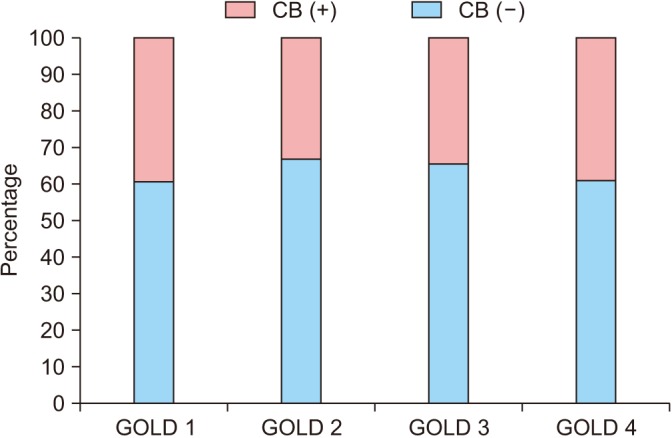Tuberc Respir Dis.
2018 Jul;81(3):228-232. 10.4046/trd.2017.0088.
Different Pattern of Chronic Obstructive Pulmonary Disease Assessment Test Score between Chronic Bronchitis and Non-chronic Bronchitis Patients
- Affiliations
-
- 1Department of Internal Medicine, Daejeon St. Mary's Hospital, College of Medicine, The Catholic University of Korea, Daejeon, Korea.
- 2Division of Pulmonology and Critical Care Medicine, Department of Internal Medicine, Inje University Haeundae Paik Hospital, Inje University College of Medicine, Busan, Korea.
- 3Division of Pulmonary, Allergy and Critical Care Medicine, Department of Internal Medicine, Konkuk University School of Medicine, Seoul, Korea.
- 4Division of Pulmonary, Allergy and Critical Care Medicine, Department of Internal Medicine, Hallym University Sacred Heart Hospital, Hallym University College of Medicine, Anyang, Korea.
- 5Division of Pulmonary, Allergy and Critical Care Medicine, Department of Internal Medicine, Seoul St. Mary's Hospital, College of Medicine, The Catholic University of Korea, Seoul, Korea. chinkook77@gmail.com
- KMID: 2414565
- DOI: http://doi.org/10.4046/trd.2017.0088
Abstract
- BACKGROUND
Chronic bronchitis (CB) is an important phenotype in chronic obstructive pulmonary disease (COPD). The purpose of this study is to evaluate different pattern of COPD assessment test (CAT) score between CB and non-CB patients.
METHODS
Patients were recruited from 45 centers in Korea, as part of the Korean COPD Subgroup Study cohort. CB was defined when sputum continued for at least 3 months.
RESULTS
Total 958 patients with COPD were eligible for analysis. Among enrolled patients, 328 (34.2%) were compatible with CB. The CAT score was significantly higher in patients with CB than non-CB, and each component of CAT score showed a similar result. CB was significantly associated with CAT score when adjusted with age, sex, modified Medical Research Council, and post-bronchodilator forced expiratory volume in 1 second. Each component of CAT score between patients with CB and non-CB showed different pattern according to Global Initiative for Chronic Obstructive Lung Disease grade.
CONCLUSION
CAT score is significantly higher in patients with CB than non-CB. Each component of CAT score was significantly different between two groups.
MeSH Terms
Figure
Reference
-
1. Rabe KF, Hurd S, Anzueto A, Barnes PJ, Buist SA, Calverley P, et al. Global strategy for the diagnosis, management, and prevention of chronic obstructive pulmonary disease: GOLD executive summary. Am J Respir Crit Care Med. 2007; 176:532–555. PMID: 17507545.2. Kim V, Han MK, Vance GB, Make BJ, Newell JD, Hokanson JE, et al. The chronic bronchitic phenotype of COPD: an analysis of the COPDGene Study. Chest. 2011; 140:626–633. PMID: 21474571.3. Annesi I, Kauffmann F. Is respiratory mucus hypersecretion really an innocent disorder? A 22-year mortality survey of 1,061 working men. Am Rev Respir Dis. 1986; 134:688–693. PMID: 3767125.4. Ekberg-Aronsson M, Lofdahl K, Nilsson JA, Lofdahl CG, Nilsson PM. Hospital admission rates among men and women with symptoms of chronic bronchitis and airflow limitation corresponding to the GOLD stages of chronic obstructive pulmonary disease: a population-based study. Respir Med. 2008; 102:109–120. PMID: 17928213.5. Meek PM, Petersen H, Washko GR, Diaz AA, Klm V, Sood A, et al. Chronic bronchitis is associated with worse symptoms and quality of life than chronic airflow obstruction. Chest. 2015; 148:408–416. PMID: 25741880.
Article6. Kim V, Criner GJ. The chronic bronchitis phenotype in chronic obstructive pulmonary disease: features and implications. Curr Opin Pulm Med. 2015; 21:133–141. PMID: 25575367.7. Agusti A, Calverley PM, Celli B, Coxson HO, Edwards LD, Lomas DA, et al. Characterisation of COPD heterogeneity in the ECLIPSE cohort. Respir Res. 2010; 11:122. PMID: 20831787.
Article8. Jones P, Harding G, Wiklund I, Berry P, Leidy N. Improving the process and outcome of care in COPD: development of a standardised assessment tool. Prim Care Respir J. 2009; 18:208–215. PMID: 19690787.
Article9. van der Molen T, Willemse BW, Schokker S, ten Hacken NH, Postma DS, Juniper EF. Development, validity and responsiveness of the Clinical COPD Questionnaire. Health Qual Life Outcomes. 2003; 1:13. PMID: 12773199.10. Jones PW, Harding G, Berry P, Wiklund I, Chen WH, Kline Leidy N. Development and first validation of the COPD Assessment Test. Eur Respir J. 2009; 34:648–654. PMID: 19720809.
Article11. Jones PW, Brusselle G, Dal Negro RW, Ferrer M, Kardos P, Levy ML, et al. Properties of the COPD assessment test in a cross-sectional European study. Eur Respir J. 2011; 38:29–35. PMID: 21565915.
Article12. Hogg JC, Chu F, Utokaparch S, Woods R, Elliott WM, Buzatu L, et al. The nature of small-airway obstruction in chronic obstructive pulmonary disease. N Engl J Med. 2004; 350:2645–2653. PMID: 15215480.
Article13. Macklem PT, Proctor DF, Hogg JC. The stability of peripheral airways. Respir Physiol. 1970; 8:191–203. PMID: 5413420.
Article14. Pothirat C, Chaiwong W, Limsukon A, Deesomchok A, Liwsrisakun C, Bumroongkit C, et al. Detection of acute deterioration in health status visit among COPD patients by monitoring COPD assessment test score. Int J Chron Obstruct Pulmon Dis. 2015; 10:277–282. PMID: 25678783.
Article15. Yoshimoto D, Nakano Y, Onishi K, Hagan G, Jones P. The relationship between the COPD Assessment Test score and airflow limitation in Japan in patients aged over 40 years with a smoking history. Int J Chron Obstruct Pulmon Dis. 2014; 9:1357–1363. PMID: 25525353.16. Sarioglu N, Hismiogullari AA, Bilen C, Erel F. Is the COPD assessment test (CAT) effective in demonstrating the systemic inflammation and other components in COPD? Rev Port Pneumol (2006). 2016; 22:11–17. PMID: 26534740.
Article17. Choi JY, Yoon HK, Park SJ, Park YB, Shin KC, Na JO, et al. Chronic bronchitis is an independently associated factor for more symptom and high-risk groups. Int J Chron Obstruct Pulmon Dis. 2016; 11:1335–1341. PMID: 27382269.



